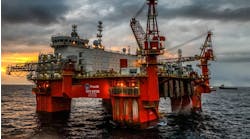'Fizzle' turns to 'sizzle' below 15,000 ft
Jim Dodson
Ted Dodson
James K. Dodson Co.
Victor Schmidt
Exploration Editor
For the Gulf of Mexico shelf, the "sizzle" at stake in drilling deep gas wells greater than 15,000 ft TVD is 10-20 tcf in gas reserves lying below current production limits. This should be sufficient to titillate the oil and gas industry's interest.
Recent deep gas wells in the range of 18,000 ft TVD are drilled and completed at an average cost of $11 million. They produce on average 33 MMcf/d of natural gas with reserves of up to 50 bcf.
Gulf of Mexico federal offshore continental shelf lease blocks color-coded by deepest well drilled in the block. Lease blocks below 15,000 ft TVD represent a new exploration frontier – the deep shelf.This compares with an average cost of $6 million to drill and complete gas wells 15,000 ft TVD or less. These wells produce 3 MMcf/d on average and are depleted within 3.5 years. This is the Gulf shelf that is "fizzling" with no bright spots, just dimmer spots as prospects.
Royalty-free incentives as now proposed offer a royalty-free prize of 16% for companies that prospect deeply in the almost 16 million acres in the Central and Western Gulf regions that lie in less than 200-m water depths. This prize amounts to $12 million on 15 bcf at $5.00/Mcf produced from 15,000-18,000 ft TVD. For wells producing at 18,000 ft TVD or deeper, the royalty-free incentive is free on the first 25 bcf of gas produced. This amounts to a prize of $20 million at $5/Mcf gas and effectively buys the first wildcat well.
That is a lot of "sizzle" compared to the dry-hole costs of up to $60 million for deepwater wells drilled in 3,000-5,000 ft of water.
Infrastructure
The Gulf shelf offers significant infrastructure advantages for deep shelf prospectors. On the shelf there are 22,000 mi of pipeline, 900 major platforms, and almost 5,000 structures, including single-well structures. In the near shore, the industry can almost drill blind based upon production that is about 4 mi away onshore from deep wells down to more than 20,000 ft TD.
In Mobile Bay, where 25,000-ft deep gas wells have been drilled, production is up to 100 MMcf/d per well. These wells can cost as much as $25 million and up to 252 days to drill on average. Even at "train-wreck" economics, a company can make a lot of money when they find a large gas reservoir. The size and quality of reservoir needed to hold such a large natural gas deposit should be discernable from available seismic information.
Wells and leases
There have been no wells drilled below 25,000 ft TVD in either the Central or Western GoM. The accompanying tables show a total of 41,541 wells drilled in the Central GoM and 5,712 wells drilled in the Western GoM. Ninty-five percent of the wells drilled were above 15,000 ft TVD. The bulk of all the wells drilled were to less than 18,000 ft. Only 324 wells tested below 18,000 ft TVD in the Central GoM, and only 29 wells were drilled below 18,000 ft in the Western GoM.
null
The lease blocks show a similar pattern. Of the Central GoM's 3,722 drilled leases, only 193 blocks were tested below 18,000 ft. The number for the Western GoM is even less. Of its 1,367 drilled leases, only 28 blocks have been tested to 18,000 ft or deeper.
This illustrates the frontier nature of the deep shelf gas play. It is a new frontier that has been lightly examined and tested.
The accompanying lease map demonstrates the potential of acreage below 15,000 ft TVD. Most Gulf of Mexico leases in the Western and Central regions have had at least one well drilled to 15,000 ft TVD below the mud line. This amounts to 4,019 blocks. In the 15,000-18,000 ft TVD range, significantly fewer leases have been tested – only 849 blocks. Below 18,000 ft TVD, the lease situation is similar to the Gulf of Mexico in the 1960s – a wide-open frontier ready for exploration and testing; only 221 blocks (4% of 5,089 blocks) have been drilled from 18,000-25,000 ft TVD.
Prospectors and the prize
With the extension of the Deep Shelf Royalty Relief program to the full GoM shelf, nearly 16 million acres are now available for deep drilling incentives. But who will explore, drill, and test these acres? Some of the companies active in the deepwater are considering returning to the shelf, but the largest leaseholds on the shelf are now owned and operated by independent oil companies.
A few years back, the majors sold their leasehold on the shelf to the independents in favor of Minerals Management Service royalty relief incentives for deepwater exploration. With the expanded Deep Shelf Royalty Relief, a few majors will be enticed back to the shelf to chase the new potential and enhance their cash flows. Shelf wells, even deep ones, are "quick to market" and can provide rapid cash infusion due to historically high gas prices expected over the next year or two.
The independents currently hold almost 11.8 million acres, compared to the majors' 3.9 million acres. The majority of this acreage is in water depths less than 350 ft. Major oil company leaseholders include BP, ChevronTexaco, ExxonMobil, Shell Oil, and Unocal.
Deep drilling is expensive due to elevated pressure and temperature regimes in the deep shelf, and many independents will not have the monetary resources to risk on deep wells. They will need the larger resources of the majors to quickly develop any discoveries. This situation opens the possibility for the majors to farm-in to shelf acreage or to develop other joint venture relationships with the current leaseholders.
Exploration over the next year will be driven by hedged production from 2002 deals. To hit the production targets for 2004, drilling must begin soon. To gain advantage from high prices and unhedged production, new drilling must find new reserves quickly. This "push" in combination with the deep shelf incentive "pull" should move the industry to rapidly take advantage of this new opportunity and delve deep into the shelf for its buried "prize" – deep shelf gas at strong prices.
The independents currently hold almost 11.8 million acres, compared to the majors' 3.9 million acres. The majority of this acreage is in water depths less than 350 ft.
Wells drilled from 1947-2003 YTD in 0-600 ft water depths comparing the Central and Western Gulf of Mexico. Wells are grouped by below mud line TVD range.
Lease blocks drilled from 1947-2003 YTD in 0-600 ft water depths comparing the Central and Western Gulf of Mexico. Leases are grouped by below mud line TVD range.







